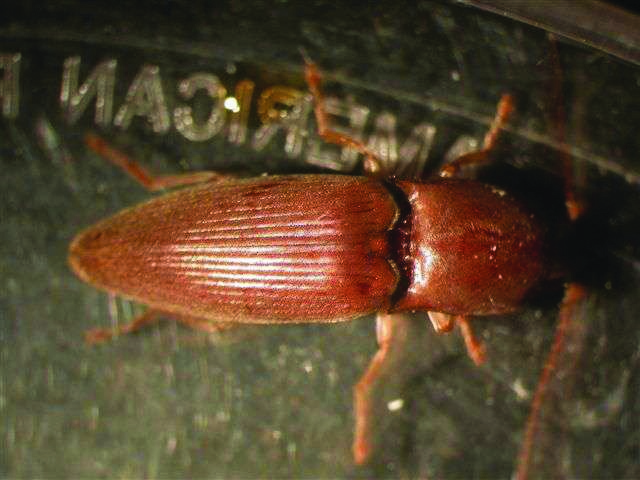
 September 28, 2009 —
September 28, 2009 —
Biotechnology and Biological Sciences Research Council (BBSRC)-funded research,
published recently in Chemical Communication, describes how scientists have
discovered molecules that could confuse insects’ ability to detect plants by
interfering with their sense of smell.
September 28, 2009 —
Biotechnology and Biological Sciences Research Council (BBSRC)-funded research,
published recently in Chemical Communication, describes how scientists have
discovered molecules that could confuse insects’ ability to detect plants by
interfering with their sense of smell.
 |
|
| A click beetle. |
This discovery could
reduce damage to crops by insect pests and contribute to food security.
“One way in which insects
find each other and their hosts is by smell, or more accurately: the detection
of chemical signals – pheromones, for example,” said lead researcher Dr Antony
Hooper of Rothamsted Research, an institute of BBSRC. “Insects smell chemicals
with their antennae; the chemical actually gets into the antennae of the insect
and then attaches to a protein called an odorant-binding protein, or OBP. This
then leads to the insect changing its behaviour in some way in response to the
smell, for example, flying towards a plant or congregating with other insects.”
Studying an OBP found in
the silkworm moth Bombyx mori, Dr Hooper and his team were able to look at how
the OBP and a relevant pheromone interact. They also tested the interaction
between OBP and other molecules that are similar to, but not the same as, the
pheromone.
“As well as learning about
the nature of this interaction we’ve actually found that there are other
compounds that bind to the OBP much more strongly than the pheromone,” said Dr.
Hooper. “We could potentially apply these compounds, or similar ones, in some
way to block the insects’ ability to detect chemical signals – the smell would
be overwhelmed by the one we introduce. We’d expect the insects to be less
likely to orientate themselves towards the crop plants, or find mates in this
case, and therefore could reduce the damage.
“There is a lot of work to
do from this point. We want to test this idea with important crop pests – we’ll
probably start with aphids because they are serious pests and we have some idea
of what the aphid OBPs are like from the genome sequence. We also hope to apply
our knowledge to insects such as tsetse flies and mosquitoes that carry human
diseases. And ultimately we’ll look at developing ways to design suitable
compounds to control these pests.”
“Around a quarter of crops
are lost to pests and diseases and so if we are to have enough food in the
future it is not just a matter of increasing gross yield,” said Professor
Douglas Kell, BBSRC chief executive. “To secure our future food supply we must
look for new and innovative ways to prevent and control pests and diseases.
This is an interesting finding that could be applied across a number of
important insect pests and may have far reaching implications for preventing
human disease as well.”
Print this page